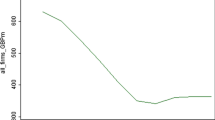Abstract
This paper examines the interactions between entry size, growth rate, and probability of survival of firm. Standard microeconomics states that firm growth stems from relative efficiency differentials and that growth positively affects the likelihood of survival. Therefore, the selection hypothesis is unable to explain how a wide number of small newly born firms can survive at length even without growth and how an even larger set of firms with a higher than average growth rate exits the market in the first few years after the foundation. It is shown that one way out of these apparent paradoxes is to relax the hypothesis of a one-to-one link between initial relative efficiency and survival, and then develop a model based on different entry modes and growth patterns of the newly born firms.
Similar content being viewed by others
References
Arrighetti, A., 1991a,Meccanismi di selezione e fattori influenti sulla mortalità delle imprese industrali, mimeo, Milano: Formaper.
Arrighetti, A., 1991b, ‘Mortalità delle imprese e l'ipotesi di selezione naturale’,Economia e politica industriale 72(3), 57–83.
Audretsch, O. B., 1991, ‘New-Firm Survival and the Technological Regime’,Review of Economics and Statistics 73(3), 441–450.
Bates, T., 1990, ‘Entrepreneur Human Capital Inputs and Small Business Longevity’,Review of Economics and Statistics 72(4), 551–559.
Carlesi, A., 1990,Il problema finanziario nell'economia della nuova impresa, Torino: Giappichelli Editore.
Caves, R. and M. Porter, 1976, ‘Barriers to Exit’, in Masson R. and D. Qualls (eds.),Essays in Industrial Organization in Honor of Joe Bain, Cambridge (Mass.): Ballinger, pp. 39–69.
Contini, B. and R. Revelli, 1986, ‘Natalità e mortalità delle imprese italiane: risultati preliminari e nuove prospettive di ricera’,L'Industria 7(2), 195–232.
Contini, B. and R. Revelli, 1987, ‘Process of job Creation and job Destruction in the Italian Economy’,Labour 1(3), 121–144.
Contini, B. and R. Revelli, 1991, ‘Pattern di espansione e di contrazione occupazionale delle imprese italiane’,L'Industria 12(4), 535–564.
Creedy, J. and P. S. Johnson, 1983, ‘Firm Formation in Manufacturing Industry’,Applied Economics 15, 177–185.
Eaton, B. C. and R. G. Lipsey, 1980, ‘Exit Barriers are Entry Barriers: the Durability of Capital as a Barrier to Entry’,Bell Journal of Economics 11, 721–729.
Evans, D. S., 1987a, ‘The Relationship between Firm Growth, Size and Age: Estimates for 100 Manufacturing Industries’, in Bresnahan T. F. and R. Schmalensee (eds.),The Empirical Renaissance in Industrial Economics, Oxford: Basil Blackwell.
Evans, D. S., 1987b, ‘Tests of Alternative Theorieis of Firm Growth’,Journal of Political Economy 95, 657–674.
Frank M. Z., 1988, ‘An Intertemporal Model of Industrial Exit’,Quarterly Journal of Economics, May, 333–344.
Hall, B. H., 1987, ‘The Relationship between Firm Size and Firm Growth in the U.S. Manufacturing Sector’, in Bresnahan T. and R. Schalensee (eds.), cit.
Hymer, S. e Pashigian P., 1962, ‘Firm Size and the Rate of Growth’,Journal of Political Economy 52 556–569.
Jovanovic, B., 1982, ‘Selection and the Evolution of the Industry’,Econometrica 50(3), 649–670.
Kumar, M. S., 1985, ‘Growth, Acquisition Activity and Firm Size: Evidence from the United Kingdom’,Journal of Industrial Economics 34 327–338.
Lucas, R., 1978, ‘On the Size Distribution of Business Firms’,Bell Journal of Economics 9, 508–523.
Mansfield, E., 1962, ‘Entry, Gibrat's Law, Innovation and the Growth of the Firms’,American Economic Review 52, 1023–1051.
O'Neil, H. M. and J. Duker, 1986, ‘Survival and Failure in Small Business’,Journal of Small Business Management, January, 30–37.
Romanelli, E., 1989, ‘Environments and Strategies of Organization Start-up: Effects on Early Survival’,Administrative Science Quarterly 34, 369–387.
Shapiro, D. and R. S. Khemani, 1987, ‘Determinants of Entry and Exit Reconsidered’,International Journal of Industrial Organization 5, 15–26.
Simon, H. and C. P. Bonini, 1958, ‘The Size Distribution of Firms’,American Economic Review 48, 607–617.
Singh, A. and G. Whittington, 1975, ‘The Size and the Growth of the Firms’,Review of Economic Studies 42, 15–26.
Storey, D. J. and A. M. Jones, 1987, ‘New Firm Formation — a Labour Market Approach to Industrial Entry’,Scottish Journal of Political Economy 34(1), 37–51.
Vivarelli, M., 1991, ‘Natalità e mortalità delle piccole imprese: un modello interpretativo’,L'Industria 12(3), 467–481.
Author information
Authors and Affiliations
Rights and permissions
About this article
Cite this article
Arrighetti, A. Entry, growth and survival of manufacturing firms. Small Bus Econ 6, 127–137 (1994). https://doi.org/10.1007/BF01065185
Received:
Issue Date:
DOI: https://doi.org/10.1007/BF01065185




